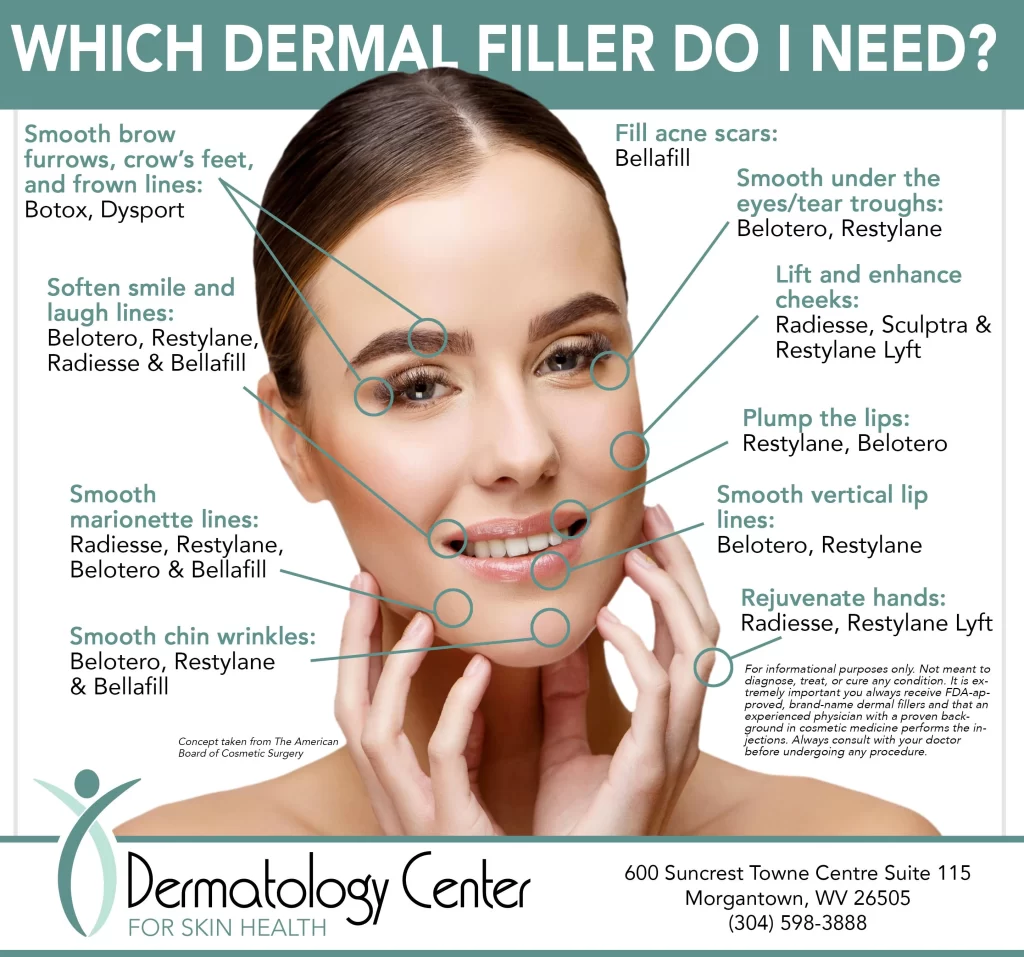Have you been thinking about ways to look and feel younger? If you are healthy, a non-smoker, have realistic treatment goals in mind and maintain good skin health, then you are the right candidate for dermal fillers.
Read more below to learn about dermal fillers and if they are safe for your skin.
DERMAL FILLERS: WHAT ARE THEY?
Fillers are a popular and cost-effective alternative for facial rejuvenation treatments with no surgery necessary. The products are gel-like substances injected beneath the skin used to ultimately restore youthful volume in the face. Dermal fillers can plump thin lips, enhance shallow contours, soften facial creases and wrinkles, improve the appearance of recessed scars, and decrease the shadow of lower lids.
Facial lines begin to appear as we age due to our faces naturally losing subcutaneous fat. This causes facial muscles to work closer to the skin surface. Besides aging, additional factors that affect your facial skin include sun exposure, heredity, and personal lifestyle.
There are a variety of dermal fillers, and the products vary based on factors like chemical makeup and longevity of the substance. There are filler products for specific areas. Fillers are categorized by what makes up the substances, and each is formulated to have texture, density, and injection depth. For example, hyaluronic acid fillers are the most temporary and recommended for first-time patients.
Dermal fillers cannot achieve the same results as a surgical facelift. Please keep in mind that dermal fillers are temporary and ongoing treatments are needed for long-lasting results.

Four Types of Fillers We Offer
- Hyaluronic Acid (HA) is a natural substance found in your skin, helping to maintain plumpness and hydration. HA fillers are soft and gel-like, leaving results that last from six to 12-months or longer. Most HA fillers are infused with lidocaine to minimize any discomfort with treatment. The U.S. Food and Drug Administration (FDA)-approved HA fillers: Juvéderm XC, VOLUMA, VOLBELLA, VOLLURE, Restylane, Restylane Silk, Restylane Lyft, Restylane Refyne, Restylane Defyne, and Belotero Balance.
- Calcium Hydroxylapatite (CaHA) is a natural substance found in our bones. In a filler, the calcium particles are suspended in a smooth gel with the consistency of a CaHA filler being thick. CaHA fillers last for about 12-months, and it is reported to stimulate collagen production. CaHA is used for deeper lines and wrinkles. FDA-approved CaHA fillers: Radiesse®
- Poly-L-lactic Acid is a safe, biodegradable synthetic substance. It has been used for many years in medical devices (i.e., dissolvable stitches). Poly-L-lactic acid products or “collagen stimulators,” smooth fine lines and allow your skin to rebuild natural collagen. It is used to treat deep facial wrinkles, leaving results to last for more than two years. FDA-approved Poly-L-lactic acid fillers include Sculptra® Aesthetic.
- Polymethylmethacrylate (PMMA) is a safe synthetic substance used in medication for the last century. PMMA forms a tiny ball that remains beneath the skin to provide continued support. Fillers with PMMA contain collagen to provide structure and firmness. FDA-approved PMMA fillers include Bellafill®.
PREPARING FOR TREATMENT
Dermal filler injections are typically non-surgical and take place during an office visit. Your treatment will begin with a consultation, where you will meet with your dermatologist to discuss your goals and any questions or concerns you may have about the procedure.
During Treatment
Just before the actual treatment, the area will be cleaned, and you may be given a topical anesthetic to numb the area before injection. Many filler products also contain lidocaine, a mild anesthetic, which is intended to help minimize discomfort during and after your treatment. Your provider will then inject a precise amount of filler strategically beneath the skin.
After Treatment
Depending on the product and the areas treated, you should be able to notice results immediately after receiving filler injections. Some patients experience mild bruising and swelling, but these are temporary and should subside over the days following treatment. You will be able to go back to your normal activities right after treatment, but your dermatologist may ask you to take the day off from exercise or other strenuous activity.
Recovery time varies for each patient, depending on which filler was used. The patient can resume most normal activities following treatment; however, it is recommended to not participate in strenuous exercise for 24 to 48 hours to reduce swelling and bruising. It will also prevent the migration of the product.
Your doctor will explain in detail the known side effects and risks as well as detailed post-treatment care with you at your appointment. Maintaining good skin health will improve longevity.
ARE DERMAL FILLERS SAFE?
It is highly recommended to make sure you are receiving FDA-approved and brand name fillers. These fillers are only available through a licensed physician, such as a board-certified dermatologist.
It is not common for participants to experience severe complications from dermal fillers. Risks and side effects vary depending on the specific type of filler used for treatment. Some side effects include:
- An over-filled appearance to treated areas
- Swelling or bruising
- Temporary redness or numbness
- Lumps or hard areas in the injection sites
- Hypersensitivity
If you are experiencing any side effects, icing or massaging can offer relief immediately following treatment.
Depending on the product used and the areas treated, you should notice results right away. The length of time the results last varies depending on the product used, the area treated, and the individual.
To maintain your results, your dermatologist simply repeat treatment, adjusting the amount and techniques as necessary to ensure optimal results.
THE CONSCIENTIOUS: ARE FILLERS GOOD FOR YOUR FACE, YES OR NO?
Overall, yes. Fillers are safe, and FDA-approved options are natural substances already found in your body. Consult with your cosmetic healthcare provider to discuss any questions, comments, or concerns you may have with dermal fillers. Depending on your goals, receiving a dermal filler is a better alternative than getting cosmetic surgery. Results may vary depending on the filler, medical professionals, and the person who is receiving the filler.
THE DERMATOLOGY CENTER FOR SKIN HEALTH, PLLC.
At the Dermatology Center for Skin Health, PLLC, our priority is to deliver quality care to informed patients in a comfortable and convenient setting. Anxious about receiving a dermal filler? Inform your dermatologist with any questions, comments, or concerns you may have about the safety of receiving a filler.
Drs. Maouad and Gharib both have extensive experience with a variety of fillers, and they perform all dermal fillers. With our team’s experiences, the risk of side effects reduces and patient satisfaction increases with proper product recommendations and placement.
Click to download our Guide to Cosmetic Procedures to learn more about dermal fillers and other cosmetic procedures you may be interested in.


